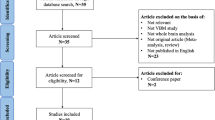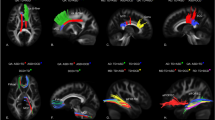Abstract
The basal ganglia portions of cortico-striato-thalamo-cortical (CSTC) circuits have consistently been implicated in the pathogenesis of Tourette syndrome, whereas motor and sensorimotor cortices in these circuits have been relatively overlooked. Using magnetic resonance imaging, we detected cortical thinning in frontal and parietal lobes in groups of Tourette syndrome children relative to controls. This thinning was most prominent in ventral portions of the sensory and motor homunculi that control the facial, orolingual and laryngeal musculature that is commonly involved in tic symptoms. Correlations of cortical thickness in sensorimotor regions with tic symptoms suggest that these brain regions are important in the pathogenesis of Tourette syndrome.
This is a preview of subscription content, access via your institution
Access options
Subscribe to this journal
Receive 12 print issues and online access
$209.00 per year
only $17.42 per issue
Buy this article
- Purchase on Springer Link
- Instant access to full article PDF
Prices may be subject to local taxes which are calculated during checkout


Similar content being viewed by others
References
Albin, R.L. & Mink, J.W. Trends Neurosci. 29, 175–182 (2006).
Hyde, T.M. et al. Neurology 45, 1176–1182 (1995).
Peterson, B.S. et al. Arch. Gen. Psychiatry 60, 415–424 (2003).
Fredericksen, K.A. et al. Neurology 58, 85–89 (2002).
Peterson, B.S. et al. Arch. Gen. Psychiatry 58, 427–440 (2001).
Schieber, M.H. J. Neurophysiol. 86, 2125–2143 (2001).
Thompson, P.M. et al. Neuroimage 23 Suppl 1: S2–S18 (2004).
Sowell, E.R. et al. J. Neurosci. 24, 8223–8231 (2004).
Leckman, J.F. et al. J. Am. Acad. Child Adolesc. Psychiatry 28, 566–573 (1989).
Spessot, A. & Peterson, B.S. in Manual of Developmental Psychopathology (eds. D. Cichetti & D.J. Cohen) 436–469 (John Wiley, Hoboken, NJ, 2006).
Singer, H.S. & Minzer, K. Brain Dev. 25 Suppl 1: S70–S84 (2003).
Singer, H.S. et al. Neurology 43, 950–956 (1993).
Ziemann, U., Paulus, W. & Rothenberger, A. Am. J. Psychiatry 154, 1277–1284 (1997).
Kalanithi, P.S. et al. Proc. Natl. Acad. Sci. USA 102, 13307–13312 (2005).
Wonders, C.P. & Anderson, S.A. Nat. Rev. Neurosci. 7, 687–696 (2006).
Acknowledgements
The authors thank J. Leckman, R. King and L. Scahill for helping to refer participants to the study. Funding support for this work was provided by a US National Institute of Mental Health grant (K01 MH01733) to E.R.S., a US National Institutes of Health (NIH)/National Center for Research Resources resource grant (P41 RR013642), NIH Roadmap for Medical Research grant (U54 RR021813) and US National Institute of Neurological Disorders and Stroke grant (NS3753) to A.W.T., NIH grants (AG016570, LM05639, EB01651 and RR019771) to P.M.T., and National Institute of Mental Health grants (MHK02-74677, MH59139 and MH068318) to B.S.P.
Author information
Authors and Affiliations
Contributions
The study was conceived and designed by E.R.S. and B.S.P., who also carried out the analysis and interpretation of the data and wrote the manuscript. A.W.T. and P.M.T. reviewed the manuscript and obtained funding for the study, along with E.R.S. and B.S.P. E.K., J.Y., D.X. and R.B. provided administrative, technical and material support. E.R.S. and B.S.P. had access to all the data in the study and take responsibility for the integrity of the data and the accuracy of the data analysis.
Corresponding author
Supplementary information
Supplementary Text and Figures
Supplementary Figures S1, S2, Supplementary Table S1 and Supplementary Methods (PDF 7550 kb)
Rights and permissions
About this article
Cite this article
Sowell, E., Kan, E., Yoshii, J. et al. Thinning of sensorimotor cortices in children with Tourette syndrome. Nat Neurosci 11, 637–639 (2008). https://doi.org/10.1038/nn.2121
Received:
Accepted:
Published:
Issue Date:
DOI: https://doi.org/10.1038/nn.2121
This article is cited by
-
Tics: neurological disorders determined by a deficit in sensorimotor gating processes
Neurological Sciences (2022)
-
Somatosensory perception–action binding in Tourette syndrome
Scientific Reports (2021)
-
Associative plasticity in supplementary motor area - motor cortex pathways in Tourette syndrome
Scientific Reports (2018)
-
Putting the Pieces Together in Gilles de la Tourette Syndrome: Exploring the Link Between Clinical Observations and the Biological Basis of Dysfunction
Brain Topography (2017)
-
Neuroimaging in Tourette Syndrome: Research Highlights from 2014 to 2015
Current Developmental Disorders Reports (2015)



